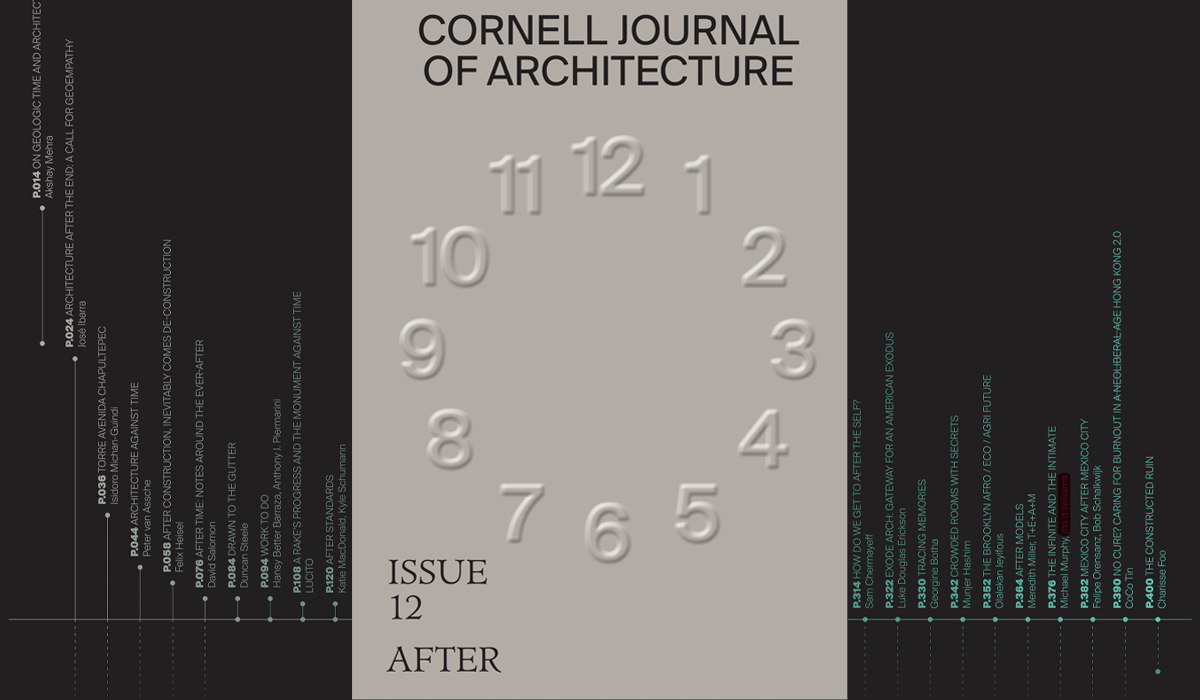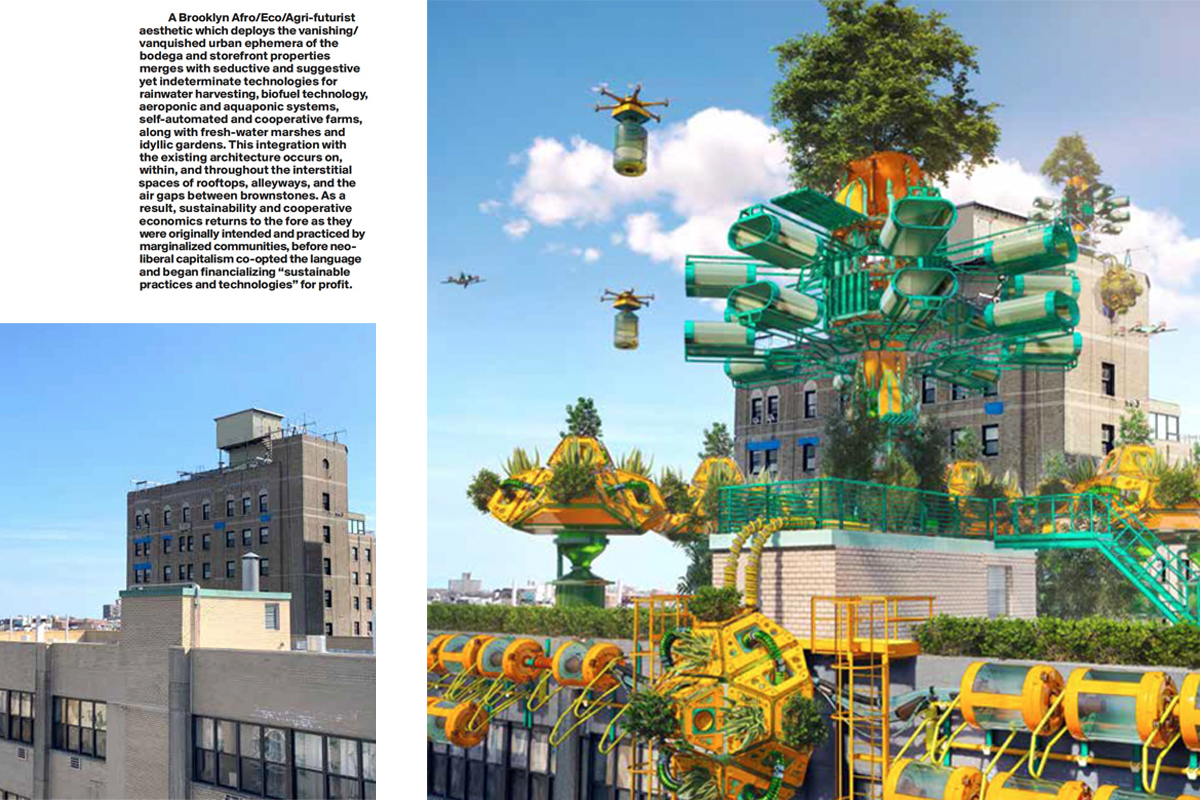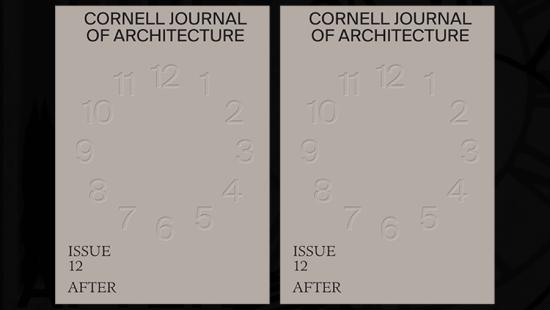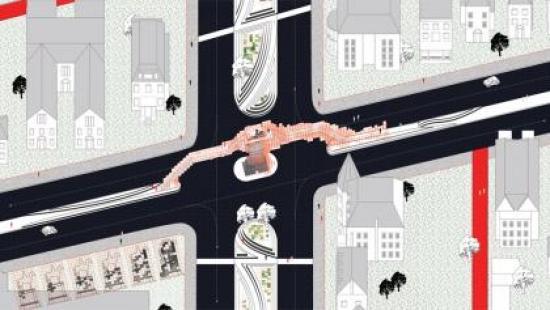Looking at After, Cornell Journal of Architecture Vol. 12
Following a pandemic-related delay, After continues the tradition of showing boundary-pushing work from faculty, students, alumni, and visitors in the Department of Architecture.

The newest critical journal Cornell Journal of Architecture (CJoA) volume 12 continues its mission of showcasing a thematic collection of work by architecture faculty, students, alumni, and visitors.
As the pandemic advanced, volume 12 also faced delays, and After is a hopeful title for both the circumstances and scope of works presented. Three opening essays set out the questions, challenges, and concepts of the theme.
Professor of architecture Andrea Simitch chaired the Department of Architecture during volume 12's production. In the first essay, titled Becoming After, she writes, "After (fear) thus seems an inevitable choice. Unlike 'fear,' which is a thing in and of itself, 'after' is almost always referencing something else, either an event that comes after something, or a slightly diminished version of the original, again dependent on the something."
Editor-in-chief and associate professor of architecture Val K. Warke's essay, An After Word, picks up the thread. "The questions one might most reasonably ask of this journal are: 'After what?' and 'After, what?' If the first question asks for a diagnosis, the second, with its understated caesura, pleads for a remedy," Warke writes.
In the third essay, Emerging After, editors and Todd Petrie (B.Arch. '20) explain, "After is a portal to a future: the possibility to reimagine and reshape our cities and buildings, to proactively respond to the growing needs of a changing world." The editors for After were students in the spring 2021 seminar Architectural Publications: CJoA 12 , led by Warke and Teaching Associate Duncan Steele (B.Arch. '20), who is also a contributor and current publication coordinator.
"As architects facing uncertain ecological, social, and political futures, we're obliged to project our work into a hereafter that can be only loosely understood. The articles in this twelfth volume hope that, in the aftermath, the architecture that emerges bears some resemblance to our own best aspirations." — Todd Petrie (B.Arch. '20)
From After
The three excerpts below offer a glimpse of the range of contributions to the most recent volume of the Cornell Journal of Architecture.
After Construction, Inevitably Comes De-construction
Assistant Professor Felix Heisel, Architecture

Left: The Mehr. WERT. Pavilion, by 2hs Architekten und Ingenieur PartGmbB and KIT Karlsruhe. photo / Zooey Braun. Center: Shards of waste glass are still visible in the final product. photo / Felix Heisel. Right: Through extensive testing, directly reused steel from a former coal-fired power plant could be utilized to assemble the tree-like structure of the pavilion. photo / Zooey Braun
"The pavilion was assembled from four different material categories: glass, steel, plastic, and mineral demolition waste. The façade and roof were made of glass panels from recycled industrial glass while the load-bearing structure consisted mainly of directly reused steel from a decommissioned coal-fired power plant. The furniture was assembled from recycled HDPE plastic waste, and the chairs were 3D-printed from plastic household waste; the pavilion floor and the landscaping of the garden were designed with various reused and recycled products from mineral demolition waste. Finally, the pavilion rested on reusable Lego-like concrete foundation blocks with a recycling aggregate content of 100%."
Blind Spots
Ihwa Choi (B.Arch. '20)

Blind Spots - the Language of Ambiguity was Choi's spring 2020 thesis project with faculty advisors Aleksandr Mergold and Andrea Simitch. 'Parcel 408' was the name of the site of the project. image / provided
"'Parcel 408' is a nameless lot in Ithaca at the intersection of Plain and Court Streets. It emerged as an intermediate zone after toxic carcinogens, a consequence of the city's early petrochemical industrial days, were discovered in the earth. It is among many intermediate zones that punctuate the landscape of Ithaca and exists as a vague specter with previous life cycles embedded into the seeming void. Defined by indeterminacy, the plot of land reflects Sola Morales's concept of 'Terrain Vague,' where its physical manifestation provides a case study to explore how residual, unofficial spaces can hold multiple, and often conflicting memories and perceptions from the public."
The Brooklyn Afro/Eco/Agri/Future
Olalekan Jeyifous (B.Arch. '00)

"A Brooklyn Afro/Eco/Agri-futurist aesthetic which deploys the vanishing/vanquished urban ephemera of the bodega and storefront properties merges with seductive and suggestive yet indeterminate technologies for rainwater harvesting, biofuel technology, aeroponic and aquaponic systems, self-automated and cooperative farms, along with fresh-water marshes and idyllic gardens."
Other contributors to After's nearly three dozen projects include Hallie Black (B.Arch. '19); LUCITO cofounders Andrew Lucia and Iroha Ito (M. Arch. '15); Michael Murphy and Jha D Williams of MASS Design Group; Katie MacDonald and Kyle Schumann, cofounders of After Architecture; and Jaret Vadera, 2019–20 Assistant Professor of the Practice in Art in conversation with Assistant Professor of History of Architecture and Urban Development Samia Henni, , among others.
Students involved in production through the summer of 2021 included managing editors Todd Petrie and Hallie Black; and submissions editors Rabei Javaid Bhatti (B.Arch. '22), Auri Ford (B.Arch. '21), Sam Gomez (B.Arch. '20), Zeli Grey (B.Arch. '22), Gracie Meek (B.Arch. '22), Jonathan Plass (B.Arch. '22), Aishwarya Sreenivas (B.Arch. '21), Chloe Tsui (B.Arch. '22), and Jessie Xiang (B.Arch. '21). Graphic design for CJOA volume 12 is by Studio Elana Schlenker.
After's editors made a special acknowledgment to the memory of Mrs. Ruth Thomas, for her belief in the importance of speaking, writing, and publishing architecture, and whose support in honor of her son, Preston Thomas, continues to provide funding and inspiration for CJoA.
A launch for CoJA Volume 12: After is scheduled for March 24. The theme of Volume 13 will be "Missing." Visit CJOA's call for submissions to learn more.
Stay connected! Follow @cornellaap on instagram, facebook, twitter, and linkedIn; and subscribe to our AAP bi-weekly newsletter.






